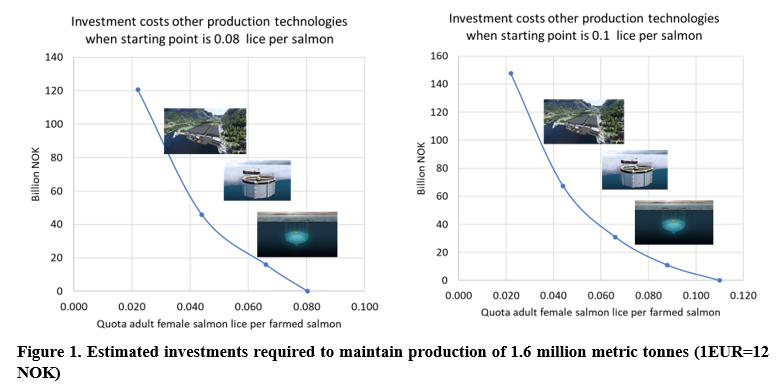EMISSION REGULATION – PROPOSED SEA LICE QUOTAS IN NORWEGIAN AQUACULTURE
In salmon aquaculture sea lice is an externality that contributes to poor welfare of farmed salmon and wild salmon mortality. Sea lice is one of the main factors limiting growth in global salmon production.
In Norway the government has tried to regulate sea lice externalities to wild salmon through a traffic light system (TLS). This system employs several methods to estimate the relationship between sea lice populations in aquaculture farms and sea lice induced mortality of wild salmon smolt migrating from rivers to the open ocean. The Norwegian coastline is divided into 13 production areas. In each production area aquaculture farms are allowed to increase production if the estimated mortality of wild smolt is below 10%, but have to reduce production if mortality is above 30%. The collective reward/punishment system in TLS is assessed to not give salmon firms sufficiently strong incentives to mitigate sea lice externalities.
In April 2025 the Norwegian government proposed a sea lice quota system to replace the collective mechanism in the TLS. The government proposes that the total sea lice quota for a production area is set equal to a level corresponding to 10% sea lice induced mortality. The quota is going to be divided between firms, probably corresponding to their allocated salmon production quota.
The dominant conventional open cage farm technology allows sea lice to migrate in and out of farms. This paper analyzes what levels of investments are necessary in alternative ‘low lice’ and ‘zero lice’ production systems to satisfy lice quotas. For each possible sea lice quota level we estimate the production technology combinations of (1) ‘low lice’ deep sea cages, (2) ‘zero lice’ sea based closed containment systems and (3) land based closed systems that can satisfy the quota with the highest net present value (NPV). Investment cost per kg of salmon produced increases substantially from deep sea systems via closed containment to land based systems. Furthermore, the production share of each production technology is constrained by nature, government regulations, etc.
Figure 1 shows the estimated investment curves maximizing NPV for different sea lice quota levels and different starting points for sea lice prevalence. It turns out that investments may be in an order of magnitude that will require a multi-year investment horizon, consuming much of the after-tax cash flow of the industry. Future after-tax cash flows in Norwegian salmon aquaculture may be 1-2 billion EUR each year, while the total investment budget may be in the order of 10 billion EUR. As indicated by Figure 1, total investments are highly sensitive to the quota levels. Required investments increase exponentially with a stricter quota, as an increasing share of production must be allocated to the more capital-intensive closed systems in sea and on land.
The effects of sea lice quota design on investment decisions are also analyzed. This includes the transition from TLS to a quota system. An immediate introduction of strict quotas will not be possible to accommodate in several production areas, due to constraints on financial capital, supplier industry capacities and government regulatory capacities. Hence, it is necessary to have a transition period with a sufficient time horizon allowing for sufficient investments and learning. The sea quota can in principle be changed over time due to changes in sea temperature, model estimates etc. We discuss constraints on quota changes, given challenges in adapting to stricter quotas.
Sea lice is also an externality between farms. We analyze the collective investment problem in a production area, as several firms must jointly invest to satisfy quota levels.
A new social contract may be necessary to enable a sustainable path to sustainable aquaculture, with the following elements:
- A sufficient time horizon for investments and adaptation, probably at least ten years.
- Salmon industry commitments to investments in the order of several billion EUR.
- Salmon companies in each production area commit to each other.
- Government commits to predictability with respect to (a) after-tax cash flow available for investments, and (2) administrative processes that enable investment projects.
It is reasonable to argue that a social contract enabling sufficient investments will require a broad political consensus to be credible.
